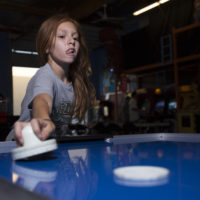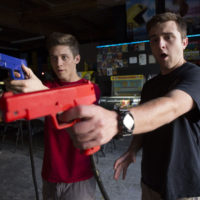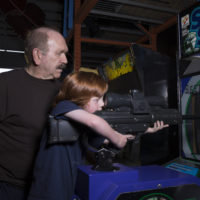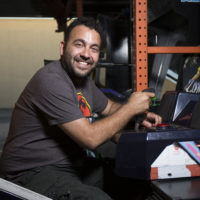The kids’ audible joy melds with the bleeps and bloops of arcade machines that are old enough to belong to their parents. Air hockey pucks smack around the tables, punctuating the laughter and talking that fills the room.
The 2,500 square-foot facility is packed, almost every machine occupied by an eager kid or parent trying to get to the next level. On the outside, it looks like another unit of the warehouse plaza off Plummer Street in Chatsworth.
Inside, it is like walking into a veritable trove of arcade machines ranging from the past 40 years.
Any person with a casual appreciation for arcade games will stand back in awe of seeing classics, such as Mario, Crystal Castles, Gauntlet and Q’Bert, along with arcade favorites from recent decades, including Silent Scope, Time Crisis, Dance Dance Revolution and the Terminator arcade game. But if this doesn’t take your fancy, and you would rather play a League of Legends game instead, then check out league of legends sales who can help you set up an account. Depending on where you live, this could be a great investment in helping you on your way to gaming glory.
This arcade was designed with almost surgical precision to target the gamut of gamers, regardless of age and playing style. Walking around the facility, it’s immediately apparent that both children, mostly younger than 10, and their parents can share the experience, something that is lost in the console gaming that is currently in vogue.
Royce D’Orazio, the owner of the eponymous arcade, sits behind the counter surrounded by a swath of pop culture memorabilia. He collects money from customers taking advantage of his arcade’s $3 unlimited play time on a cloudy, damp Saturday afternoon.
What started as a simple repair and rental service for arcade machines in D’Orazio’s garage has transformed into a multifarious business that is injecting nostalgia into the 21st century Angeleno social life.
“I started with nothing but street signs with no words, just dots and arrows, Pac-Man and ghosts, and people would come to me like, ‘I saw the arrow, I followed the dots. I didn’t know where it was going to take me, but I knew it was going to take me somewhere cool,’” D’Orazio says.
He explains that after parenting blogs and news media picked up his stuff, constantly setting up the sign trail became unnecessary.
D’Orazio, a Philadelphia native in his 30s, shifted from working in the entertainment industry once his talents for arcade repairs proved to be profitable. Talking to him is like listening to an amalgamation of a fervent gaming fan and an astute businessman whose ambition for future projects is palpable. He knows the lexicon of gaming and he translates it into a business model.
He offers arcade machine rentals, restorations and repairs across the Southland, as well as hosting affordable parties in the warehouse space and $3 dollar unlimited play for all two times a week during the school year.
Royce is experiencing a meteoric rise as one of Los Angeles’ few arcade guys riding the nostalgia wave that has swept the city.
A casual consumer of contemporary pop culture can immediately recognize the fervor for arcades and all things ‘90s.
Many icons who were successful in this era are seeing a resurgence because of this.
“You want to know why arcades are now so important in Los Angeles? It’s ‘90s nostalgia and the joystick fire button combo,” TV host and producer Phil Moore jokes about the revival of the arcade experience. “The ‘90s are a huge influence on entertainment today. Take ‘Fuller House,’ the Disney live action remakes, the Power Rangers movie, etc.”
“As the former host of ‘Nick Arcade’ on Nickelodeon,” Moore continues. “I’m making more appearances at [conventions] and gaming expos than ever before, because those ‘90s kids are now adults and they love reliving the childhood. And playing classic video games is an important part of that experience.”
A $3 arcade adventure may sound like a great deal, but it is actually a well plotted move for D’Orazio.
“Creating the arcade experience was a marketing strategy. When I opened, I was doing party rentals. I got this space and thought the best thing I have going for me are the games, so I put them to work. I mean this product is not a hard sell,” D’Orazio says.
Over time, numerous aspects of D’Orazio’s approach to conducting business have changed.
“I used to let people come here for free because I thought people will love it and find ways to embrace the business,” D’Orazio says. “Now, we charge an admission fee, which has become its own revenue stream.”
This thought out marketing tactic has garnered praise from a slew of blogs and the L.A. Mayor’s office as well.
“We got recognized by the Mayor’s office and several other entities. I wasn’t looking for those things but it’s really cool,” D’Orazio says.
Walking around the arcade, it isn’t difficult to find a parent who has something good to say about it.
“My kids really enjoy coming here. We go almost every Saturday now,” says mother of two Linda Henderson. “It’s so cheap and getting my daughter to play Pac-Man beats her begging for my phone to play Fruit Ninja.”
As the arcade continues to grow in popularity, it has proven to be as beneficial for kids with disabilities as well.
“There’s a massive social component that’s lost on the console where you see kids are isolated. Something that I discovered is that for children with autism or Asperger’s syndrome, this place is very good for them,” D’Orazio says. “We get kids like that, and not only does it feed all of their senses, but to find the next game they have to actually be social, so it forces them in a very natural way. I never expected kids be nurtured by the arcade.”
It is an unconventional thought to label an arcade as nurturing, but as D’Orazio says, it makes sense.
“You’ve got to remember when arcades existed [in the ‘70s and ‘80s], autism was a fringe disability,” D’Orazio says. “They come in here and it’s like their own place. I guess it’s soothing to them. I can’t speak for them, but I just had one of these kid’s mothers come back and when we were talking, she said when her son comes here, he feels empowered.”
While parties remain the centerpiece of the arcade, he plans to produce social media content to build the brand’s presence on the web, including videos on the popular gaming streaming service Twitch.
“We [plan on] rolling out content every day of the week, video content like toy unboxing, vintage game displays, interviews, round table discussions, Twitch competitions,” he says. “You could come here on a Friday and play someone in Street Fighter live on Twitch and also potentially see your gameplay posted on our social.”
On top of the new content, sometime in the near-future D’Orazio hopes to open a new facility that feels more akin to an indoor Disneyland, with a mini kart track and possibly even a roller coaster, if the desired space allows it.
The goal for D’Orazio is to keep arcade gaming alive for the next generation.
“There’s a way parents connect with their kids here that they’re not going to get at Chuck E. Cheese. You can show your son or daughter how you play Donkey Kong and get them involved. That’s something you can’t get at home.” D’Orazio says. “Arcades are essential in nurturing the younger kids to hopefully keep the arcade experience alive.”








